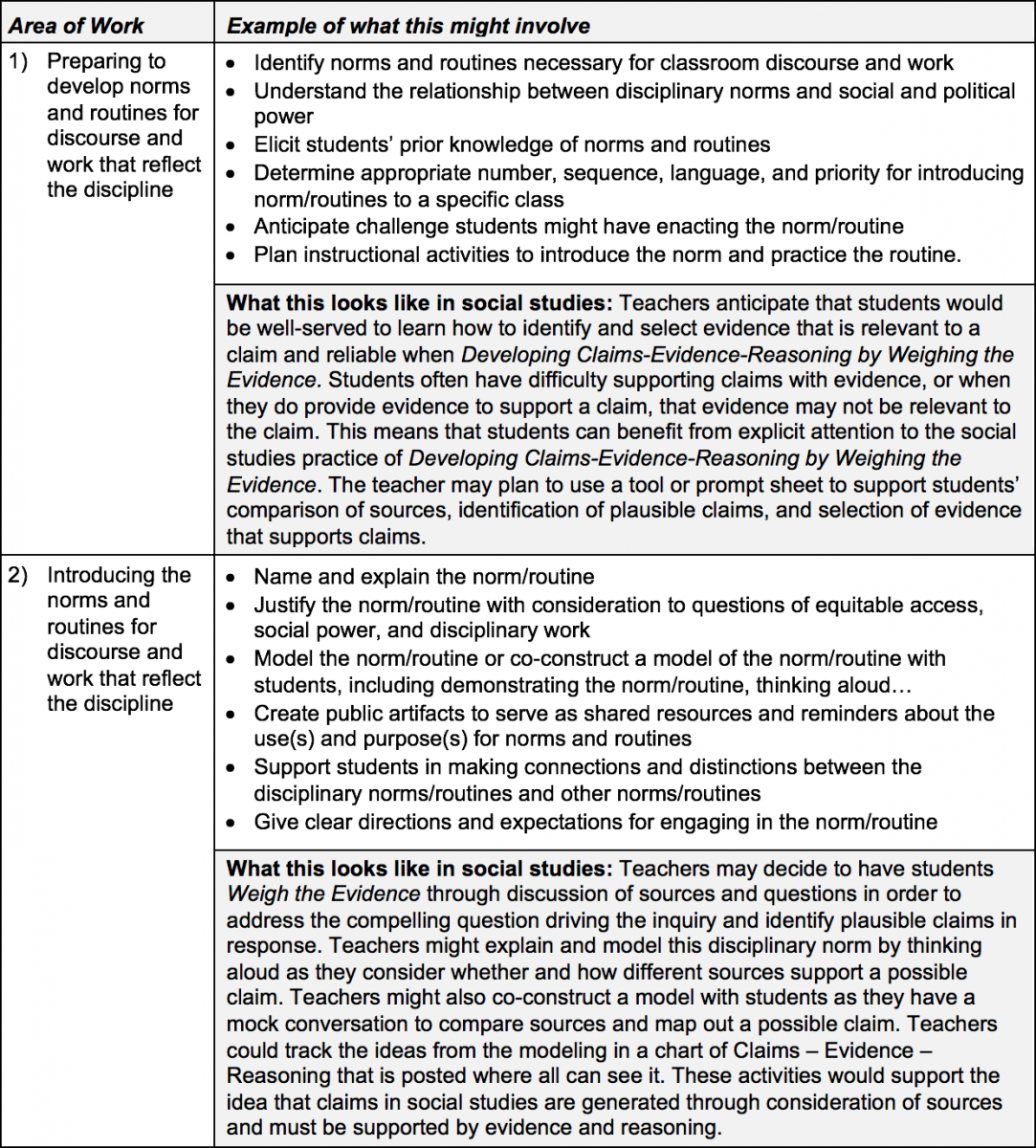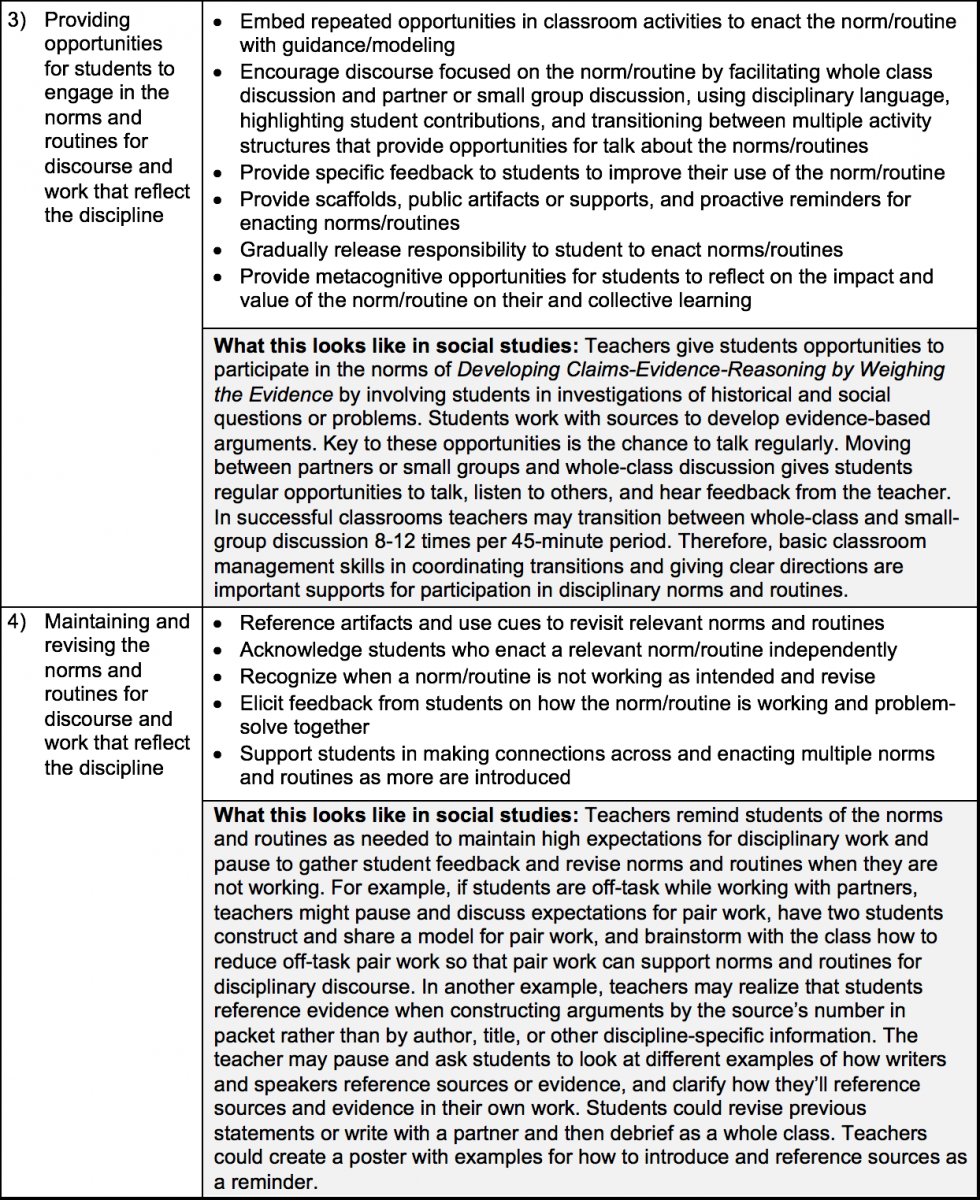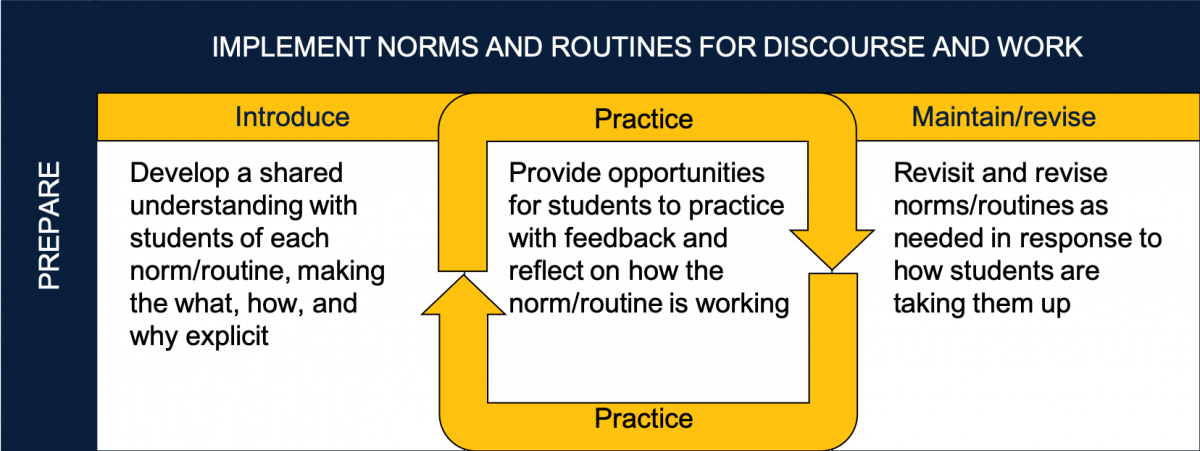What is implementing norms and routines for classroom discourse and work in social studies?
Each content area has norms and routines that reflect the ways in which people in their field construct and share knowledge. In social studies, norms include ways of thinking and working that social scientists and historians engage in. Examples of norms in history/social science include (1) analyzing sources by sourcing, contextualizing, and corroborating (see Wineburg, 2001, for seminal work in this area); (2) developing claims, evidence, and reasoning by weighing the evidence; (3) recognizing multiple perspectives; or (4) considering causes and consequences. These norms are disciplinary practices and concepts that are central to understanding social and historical issues as well as developing and critiquing interpretations or arguments. They are norms for thinking in the social studies disciplines.
In this set of resources, we focus on the disciplinary norm of developing claims, evidence, and reasoning by weighing the evidence and draw on materials from Read.Inquire.Write. This norm may also be referred to as argumentation or constructing evidence-based interpretations. Any investigation of historical or social questions involves sifting through sources to determine what arguments emerge from the evidence. Students compare sources to identify possible responses to a central or compelling question, select relevant and reliable evidence that supports those claims, learn to introduce and cite supporting evidence, explain how the evidence supports each claim and why the evidence is reliable for the central question or problem under investigation. Through discussion and use of supporting tools, weighing the evidence leads students to identify stronger arguments on the basis of the claims, evidence, and reasoning.
Routines are ways of working in the classroom that allow students to learn about and practice these norms. In order to implement norms and routines effectively, teachers must introduce these norms and routines carefully, provide opportunities to practice, and maintain and revise students’ efforts by providing feedback and opportunities for reflection.
Advancing justice through implementing norms and routines
Acquiring the skills necessary for participation in academic discourse is essential to students’ future success. In social studies, students must be able to analyze sources, use evidence and develop arguments in order to compose essays that allow them to progress in secondary school, higher education, and beyond. Introducing and practicing with these norms makes explicit the codes or rules that undergird the “culture of power” (Delpit, 1988) in academic spaces. In other words, teaching norms and routines can provide more equitable access to learning.
Learning to implement norms and routines is a part of developing competence as a teacher. In the classrooms of skilled social studies teachers, students share their ideas about historical and social problems, identify more and less reliable evidence, and ask provocative questions about the world. This does not happen out of thin air; these students have been taught how to participate in social studies discourse and bring their own resources to such discussions. Competent teachers implement norms and routines by introducing, practicing, and maintaining these routines.
Finally, teaching norms and routines for discourse and work conveys respect and high expectations for students. Teaching norms and routines communicates to students that they are capable of high levels of thinking and that their thinking is valued.
Why work on implementing norms and routines for classroom discourse and work in social studies?
Educational experts have long noted drastic differences between what students do in social studies class and what social scientists do in their daily work (see for example, Bruner, 1960). While memorizing facts and learning a single story or set of information has dominated social studies classrooms, research has found that historians show specific ways of reading and working such as sourcing, contextualizing, and corroborating sources (Wineburg, 1991) or argumentation and writing to communicate (Monte-Sano & Thomson, 2015). The C3 Framework argues that these skills, among others, are central to preparing good citizens and college-ready students. But, students need to practice these discipline-specific ways of thinking and working. Teachers, then, can develop norms and routines for inquiry that make this type of thinking part of the fabric of the social studies classroom.
Decomposition
The areas of work below create a sequence of steps that are often employed in classrooms where social studies inquiry is commonplace. In terms of activity structures, we typically see teachers start off as a whole class to introduce the norm, then rotate between pair or small group work and whole-class discussion so that students have regular opportunities to participate in talk about the norms. As a consequence, transitions between activity structures are important and require basic management skills. Taken together, these areas of work create a routine for inquiry which provide opportunities for students to learn and try out disciplinary practices or other ways of thinking common to social scientists and historians. This decomposition might be used to help teacher candidates analyze a video, structure a lesson, or reflect on an enactment.



Supporting Novice Teachers
Implementing norms and routines for classroom discourse and work in social studies requires novices to pull together several high-leverage practices in social studies (modeling, supporting small groups, leading whole-class discussion). Novice teachers often have difficulty pulling together and coordinating multiple high-leverage practices while also managing students and materials. So, some practice in transitioning between activity structures and activities used to participate in norms and routines and practice in planning out the different steps involved in the routines they’d like to use will help novices. Another area of challenge is novices’ knowledge of disciplinary norms; therefore, time spent learning and practicing disciplinary norms will support novices’ implementation of norms and routines. The first two activities in the social studies modeling learning cycle support novices’ disciplinary learning, as do the first few activities in this learning cycle.